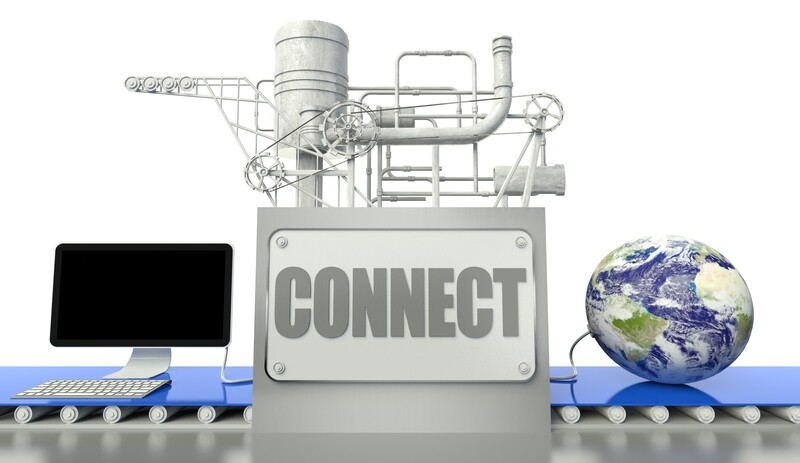Jump on the Wave of the Fourth Industrial Revolution Today
2015-11-24
Peter Bílik, EMANS Solution Designer, ANASOFT
Industry 4.0 is not so distant and futuristic as it may seem

15 years ago when I used to go on vacation by car, my wife navigated me with a map spread out on her lap. It meant that sometimes I didn’t know if I should take turn onto the nearest side street or if I should have turned at the previous intersection. Since the radio traffic service was the only dynamic information for us, we learned about traffic jams on the highway - usually when we were already stuck there; we also had no idea about speed traps.
There was a certain charm to it, I admit. But I much prefer today’s navigation methods. Your cellular phone has a free Waze navigation application, which knows exactly your traveling speed, your destination and the best route. Since the maps are permanently updated, Waze would never send you to one-way street just because last year it was still a two-way street. The app can evaluate on its own or based on input from other connected drivers about something that happened on your route. And based on that information, it will not only adjust your estimated time of arrival; it also will propose a detour.
Social Networks in Industry
Waze uses the social networking principle since it is the de facto social network of drivers. They can manually feed into the system information that is useful for other travelers, such as traffic jams, police checks, ongoing street events or gasoline prices. Data entry is simple and clear and doesn’t cause any complications to drivers passing through problematic areas. But most of all, this application automatically collects all of the data from each connected device and evaluates them in actual time. The data are then analyzed in order to provide useful information and propose optimal routes to all users.
The principles of social networks on which Waze is based have already made their way to industrial production. Industry 4.0 has recently become a frequently used term. Coined by the German government several years ago, it designates the method of using information and communication technology which promises changes comparable to those brought about by industrial revolutions in the past.
For the sake of review, the steam engine and electrification resulted in the creation of factories and the migration of the labor force from agriculture to manufacturing and thus the first more distinctive improvement of living standards. The third industrial revolution came about in the middle of the past century when the automation and robotizing of manufacturing began.

New Era Foundations
All of these milestones increased productivity, but in recent decades the manufacturing industry has lagged behind certain other sectors. Digitizing, which is usually related to the term Industry 4.0, should bring a new wave in the growth of effectivity and productivity. Its essence won’t be in adding more control units but in their mutual interconnection, which will ensure that everything in a factory can mutually communicate and provide smart support to workers.
The Internet of Things is the fundamental building block of this concept. Not in the sense of a smart fridge which automatically orders food and drink supplies. A factory in the Industry 4.0 era has three key components:
- First – it is equipped with sensors that continually collect data from machines, devices, assembly lines, warehouses, materials and other components.
- Second – it is interwoven by a communication infrastructure through which machines can communicate with each other, people and various IT systems.
- And third – it uses software which can not only collect all of the data, but subsequently evaluate them, analyze them and draw conclusions. In other words, it brings intelligence and order to a cluster of data.
What We Gain
In practice, this may mean that if one machine needs unplanned maintenance immediately and maintenance for the machine next to it is scheduled for the next day, the system will automatically record these requirements and automatically determine that the service technician can be called only once and not two times. Or, the system will automatically find out that a certain operation such as the tightening of screws increases the risk of loosening tubes on the other side of the product and it will point out the need for increased attention or additional checks. This should result in faster, more flexible and effective processes, lower defect rates and better quality products manufactured at lower costs.
Such vision may sound futuristic. But in fact even today there are factories operating according to Industry 4.0 principles. The factory is an example of the progressive integration of smart and mutually interconnected machines operated by humans.
The Boat Is Leaving...
 In spite of this, smaller and medium size enterprises may consider Industry 4.0 to be a distant fantasy that isn’t worth paying attention to or premature in light of every day operation problems. Maybe this is what some businesses were thinking over a hundred years ago when Henry Ford introduced the first moving assembly line - an innovation that cut the manufacturing time of one car from over 12 man/hours to an hour and a half, not to mention other benefits such as the elimination of occupational injuries.
In spite of this, smaller and medium size enterprises may consider Industry 4.0 to be a distant fantasy that isn’t worth paying attention to or premature in light of every day operation problems. Maybe this is what some businesses were thinking over a hundred years ago when Henry Ford introduced the first moving assembly line - an innovation that cut the manufacturing time of one car from over 12 man/hours to an hour and a half, not to mention other benefits such as the elimination of occupational injuries.
It’s no wonder that it brought Ford worldwide success and made it the symbol of motoring and the introduction of cars to the middle class.
Sure, industry technology is far from where it was a hundred years ago. But the basic principle of the moving assembly line has not changed. The same applies to Industry 4.0. The basic principles and infrastructure that a factory establishes today will survive for years. It is important not to miss the boat and to begin as soon as possible, even with just baby steps. . .
YOU MIGHT ALSO BE INTERESTED IN
- Industry 4.0 the Main Topic at the Davos World Economic Forum
- The Fourth Industrial Revolution Has Already Begun
- Will the fifth industrial revolution save the world?
- 3 Unknown Ways to Use Kinect
- 3 Things Which Every Production Manager Wants to Improve







